The Spatial Analysis and Sustainability of Rural Cultural Landscapes: Linpan Settlements in China’s Chengdu Plain
Abstract
:1. Introduction
2. Materials and Methods
2.1. Research Area
- Juyuan Town is in the core zone of Dujiangyan City’s elite irrigation district—it has a rich cultural history, which is of great significance for understanding the evolution of Linpan settlements. Moreover, the town is the first through which gravity irrigation water flows, making it a good model for examining the relationship between human activity and the natural environment;
- In China, most rural areas are underdeveloped, and relevant information or data is complicated to obtain. However, since the Wenchuan earthquake in 2008, we have conducted a continuous follow-up study on Juyuan Town for nearly ten years. The previous research findings are very beneficial to the in-depth study of the area and similar rural areas;
- It is a key municipality in Dujiangyan City (Key towns are geographically big with high populations, well-developed economies, and complete supportive facilities. Their construction effectively balances the distribution of relocated rural residents, and reduces the population burden on large cities), located in an urban-rural intersection. The town is facing the pressure of urbanization, as well as the threat of the destruction of traditional cultural landscapes. Thus, it is urgent that the sustainability of local cultural landscapes be investigated.
2.2. Defining Linpan Cultural Landscape
2.3. Methodology
3. Case Study
3.1. The Hierarchy of Linpan Settlements
3.2. The Spatial Structure of Linpan Settlements
3.2.1. The Distribution of Linpan Settlements
3.2.2. Relationship between Life and Production Space
3.3. Type Conversion
3.3.1. Type I: Internal Changes
- Spatialreplacement (Figure 6a). More open space is obtained by reducing the number of trees to meet farmers’ daily living needs (such as parking, leisure, and production). This reflects the self-regulation and lifestyle of local residents in relation to the residential environment, based on their customs and behavior when adapting to modern life.
- Functionalreplacement (Figure 6b). Forests outside Linpan settlements provide shelter from the wind and protect the soil. At present, they are gradually being replaced by cement walls or iron gauze, demonstrating improvement in residents’ security awareness, promotion of land tenure awareness (i.e., boundaries), and greater concern about personal privacy [41].
- Old-for-new replacement (Figure 6c). With the enhancement of farmers’ living standards, many traditional residential buildings in western Sichuan cannot meet the needs of modern living. Numerous old buildings in Linpan settlements have been demolished, with new houses erected on site. After the 2008 earthquake, countless old buildings were damaged to varying degrees. The post-disaster recovery and reconstruction resulted in the construction of multi-story (2–3 stories) single-family buildings with a large number of brick-concrete structures (verified through the field survey). To a large extent, this shows that improved economic status leads to changes in rural scenery. Off-site migration consists of two modes: Centralized building (at a different site) versus construction by residents (on their own).
- Newrural communities. As presented in Figure 6d, several neighboring Linpan settlements are merged into a group, while uniformly placing the original residents in newly built rural communities in response to the “Three Concentrations” policy (The “Three Concentrations” policy is the fundamental approach for coordinating urban and rural growth, promoting urban-rural integration, and solving the “three rural issues.” Industry is concentrated in centralized development zones, farmers are placed in towns and new kinds of communities, and the land is used for operations on a moderate scale) regarding land readjustment in rural areas.
- Off-site construction. As shown in Figure 6e, when Linpan settlements’ size and relationship to the land are exploited to the maximum extent, the residents living there will build new homes around the original settlement, mostly 2–3 story, brick-concrete, single-family buildings, similar to those in type IA-c. The selection of the location for the new houses is no longer predicated on whether the new areas have well-developed river systems. Instead, the primary consideration becomes whether the new homes are in close proximity to roads.
3.3.2. Type II: Morphological Changes
- In unconstrained expansion, the extension of the boundary is free from apparent environmental constraints. Afterwards, the morphology is similar to the original one. The expansion can be one of two types: The growth of native trees or the planting of new seedlings;
- In joint expansion, adjacent Linpan settlements are gradually integrated into an overall body. Linpan settlements established through joint expansion are strip-shaped and contain two or more family clans with different surnames;
- In constrained expansion, due to geographical obstacles (such as roads, canals and rivers), the boundary undergoes irregular extension. The Linpan settlements are unevenly distributed, and the shape after the expansion is inconsistent with the one from before.
3.3.3. Type III: External Landscape Changes
4. Results and Findings
4.1. Change Statistics
4.2. Discussion on Demand and Sustainability
5. Conclusions
Author Contributions
Funding
Acknowledgments
Conflicts of Interest
References
- Anderson, K.; Domosh, M.; Pile, S.; Thrift, N. Handbook of Cultural Geography; Sage: Thousand Oaks, CA, USA, 2002. [Google Scholar]
- Mikesell, M.W. Landscape. Int. Encycl. Soc. Sci. 1968, 8, 575–580. [Google Scholar]
- Fowler, P.J. World Heritage Paper 6: World Heritage Cultural Landscape 1992–2002; UNESCO World Heritage Centre: Paris, France, 2003; p. 22. [Google Scholar]
- Sauer, C.O. The Morphology of Landscape. Univ. Calif. Publ. Geogr. 1925, 2, 19–54. [Google Scholar]
- Bi, J. Research on the Sustainable Development of Wutai Mountain Cultural Landscape from the Perspective of Ecological Philosophy. Ph.D. Thesis, Shanxi University, Taiyuan, China, 2013. [Google Scholar]
- Antrop, M. Why Landscapes of the Past Are Important for the Future. Landsc. Urban. Plan. 2005, 70, 21–34. [Google Scholar] [CrossRef]
- Wei, H. China’s Urbanization: The Road to Harmony and Prosperity; Social Sciences Academic Press: Beijing, China, 2014. [Google Scholar]
- Antrop, M. Changing Patterns in the Urbanized Countryside of Western Europe. J. Landsc. Ecol. 2000, 35, 257–270. [Google Scholar] [CrossRef]
- Ahadnejad, M.; Maruyama, Y.; Yamazaki, F. Evaluation and Forecast of Human Impacts Based on Land Use Changes Using Multi-Temporal Satellite Imagery and GIS: A Case Study on Zanjan, Iran. J. Indian Soc. Remote 2009, 37, 659–669. [Google Scholar] [CrossRef]
- Araya, Y.H.; Cabral, P. Analysis and Modeling of Urban Land Cover Change in Setúbal and Sesimbra, Portugal. Remote Sens. 2010, 2, 1549–1563. [Google Scholar] [CrossRef]
- Bürgi, M.; Straub, A.; Gimmi, U.; Salzmann, D. The Recent Landscape History of Limpach Valley, Switzerland: Considering Three Empirical Hypotheses on Driving Forces of Landscape Change. Landsc. Ecol. 2010, 25, 287–297. [Google Scholar] [CrossRef]
- Jiao, Y. Synthetic Assessment on the Multifunction of Terrace Landscape in Ailao Mountains. Yunnan Geogr. Environ. Res. 2008, 20, 7–10. [Google Scholar]
- Shi, M.; Xie, Y.; Cao, Q. The Landscape Evolution and Mechanism Analysis of Rural Settlements in the Oasis of Arid Region. Geogr. Res. 2016, 35, 692–702. [Google Scholar]
- Stockdale, A.; Barker, A. Sustainability and the Multifunctional Landscape: An Assessment of Approaches to Planning and Management in the Cairngorms National Park. Land Use Policy 2009, 26, 479–492. [Google Scholar] [CrossRef]
- World Rural Landscapes: A Worldwide Initiative for Global Conservation and Management of Rural Landscapes. Available online: http://www.worldrurallandscapes.org/ (accessed on 2 February 2015).
- Fan, Y.; Wu, Y. The Sustainable Development of Qiang Ethnic Indigenous Villages in the Context of New Urbanization. Eco-Econ. 2014, 30, 47–51. [Google Scholar]
- Liu, F. Study on Creating Rural Landscape Features under New Local View. Anhui Archit. 2013, 19, 19–20. [Google Scholar]
- Fowler, P. World Heritage Cultural Landscapes, 1992–2002: A Review and Prospect. In Cultural Landscapes: The Challenges of Conservation, Ferrara, Italy; UNESCO World Heritage Centre: Paris, France, 2002; p. 16. [Google Scholar]
- Council of Europe. The European Landscape Convention; Council of Europe: Strasbourg, France, 2000. [Google Scholar]
- Rodwell, D. Conservation and Sustainability in Historic Cities; John Wiley & Sons: Hoboken, NJ, USA, 2008. [Google Scholar]
- Fang, Z.; Zhou, J. Population, Cultivated Land and the Self-organization of Traditional Rural Settlement—With the Case of the Linpan Settlement System (1644–1911) in Chuanxi Plain. Chin. Gard. 2011, 27, 83–87. [Google Scholar]
- Antrop, M.; Van, E.V. Holistic Aspects of Suburban Landscapes: Visual Image Interpretation and Landscape Metrics. Landsc. Urban. Plan. 2000, 50, 43–58. [Google Scholar] [CrossRef]
- Duan, P.; Liu, T. Linpan: Ecological Home of Shu Culture; Sichuan Science and Technology Press: Chengdu, China, 2004. [Google Scholar]
- Fang, Z. Essentials of Linpan Culture in Western Sichuan. Ph.D. Thesis, Chongqing University, Chongqing, China, 2012. [Google Scholar]
- Sun, D. Research on the Protection and Development Model of Linpan Landscape Resources in Western Sichuan. Ph.D. Thesis, Sichuan Agricultural University, Ya’an, China, 2011. [Google Scholar]
- Zhang, Y. Research on the Protection and Development of Linpan System in Western Sichuan. Ph.D. Thesis, Southwest Jiaotong University, Sichuan, China, 2008. [Google Scholar]
- Ishikawa, M. Sustainable Development of Heritage Protection. China Homes 2016, 5, 44–45. [Google Scholar]
- Turne, M.C.; Gardner, R.H. Quantitative Methods in Landscape Ecology: The Analysis and Interpretation of Landscape Heterogeneity; Springer: New York, NY, USA, 1990. [Google Scholar]
- Tang, M. The Inventory and Progress of Cultural Landscape Study. Prog. Geogr. 2000, 19, 70–79. [Google Scholar]
- Fan, J.; Zhang, W.; Lei, Y. Review and prospect of the development of landscape geography abroad. World Geogr. Res. 2007, 1, 83–89. [Google Scholar]
- Zhang, Z.; Qiu, Z.; Wang, Z. Exploration of Evolution Mechanism and Renewal Strategy of Traditional Rural Settlements Based on Typology. Archit. J. 2017, S2, 7–12. [Google Scholar] [CrossRef]
- Liu, H. Study on the Rural Landscape Pattern and Settlement (Linpan) Pattern of Xujia Town, Dujiangyan City. Ph.D. Thesis, Sichuan Agricultural University, Sichuan, China, 2012. [Google Scholar]
- Yin, L.; Cai, J. Study on the Sustainable Development Path of Linpan Landscape in Chengdu Plain. Lands. Res. 2010, 12, 11. (In English) [Google Scholar]
- Fang, Z.; Li, X. Analysis on Linpan Cultural Value in Western Sichuan. J. Xihua Univ. Philos. Soc. Sci. 2011, 30, 26–30. [Google Scholar]
- Chen, Q.; Yang, J.; Luo, S.; Sun, D. Identification and Extraction of the Linpan Culture Landscape Gene. Trop. Geogr. 2019, 39, 254–266. [Google Scholar]
- Zheng, J. On Ecological Significance of Linpan Domain in West of Sichuan. Shanxi Archit. 2010, 36, 50–52. [Google Scholar]
- Roberts, B. Landscapes of Settlement: Prehistory to the Present; Routledge: Abingdon, UK, 2013. [Google Scholar]
- Qiao, W.; Wu, J.; Zhang, X.; Ji, Y.; Li, H.; Wang, Y. Optimization of Spatial Distribution of Rural Settlements at County Scale Based on Analysis of Farming Radius—A Case Study of Yongqiao District in Anhui Province. Resour. Environ. Yangtze Basin 2013, 22, 1557–1563. [Google Scholar]
- Jiao, Y.; Hu, W.; Su, S.; Fan, T.; Yang, Y. Spatial Pattern and Farming Radius of Hani’s Settlements in Ailao Mountain Using GIS. Resour. Sci. 2006, 28, 66–72. [Google Scholar]
- Birks, H.H.; Birks, H.J.B.; Kaland, P.E.; Moe, D. (Eds.) The Cultural Landscape: Past, Present and Future; Cambridge University Press: Cambridge, UK, 1988. [Google Scholar]
- Cai, X. Analysis of the Value of Traditional Rural Dwellings–Taking the Linpan Settlement in Western Sichuan as an Example. Theory Reform 2009, 4, 151–153. [Google Scholar]
- Zheng, J.; Zhu, H. Research Report on the Protection, Development and Utilization of Linpan Culture in Western Sichuan. J. Chengdu Munic. Party Coll. C.P.C. 2008, 2, 71–74. [Google Scholar]
- Ding, S.; Dianhong, Z. Research on the Zoning Methods in Rural Areas from the Perspective of Cultural Landscape: A Case Study of the Fan-Shape Area in Dujiangyan. Urban. Rural Plan. 2018, 6, 88–97. [Google Scholar]
- Whelan, Y. Heritage, Memory and the Politics of Identity: New Perspectives on the Cultural Landscape; Routledge: Abingdon, UK, 2016. [Google Scholar]
- Holden, E.; Linnerud, K.; Banister, D. Sustainable Development: Our Common Future Revisited. Glob. Environ. Chang. 2014, 26, 130–139. [Google Scholar] [CrossRef]
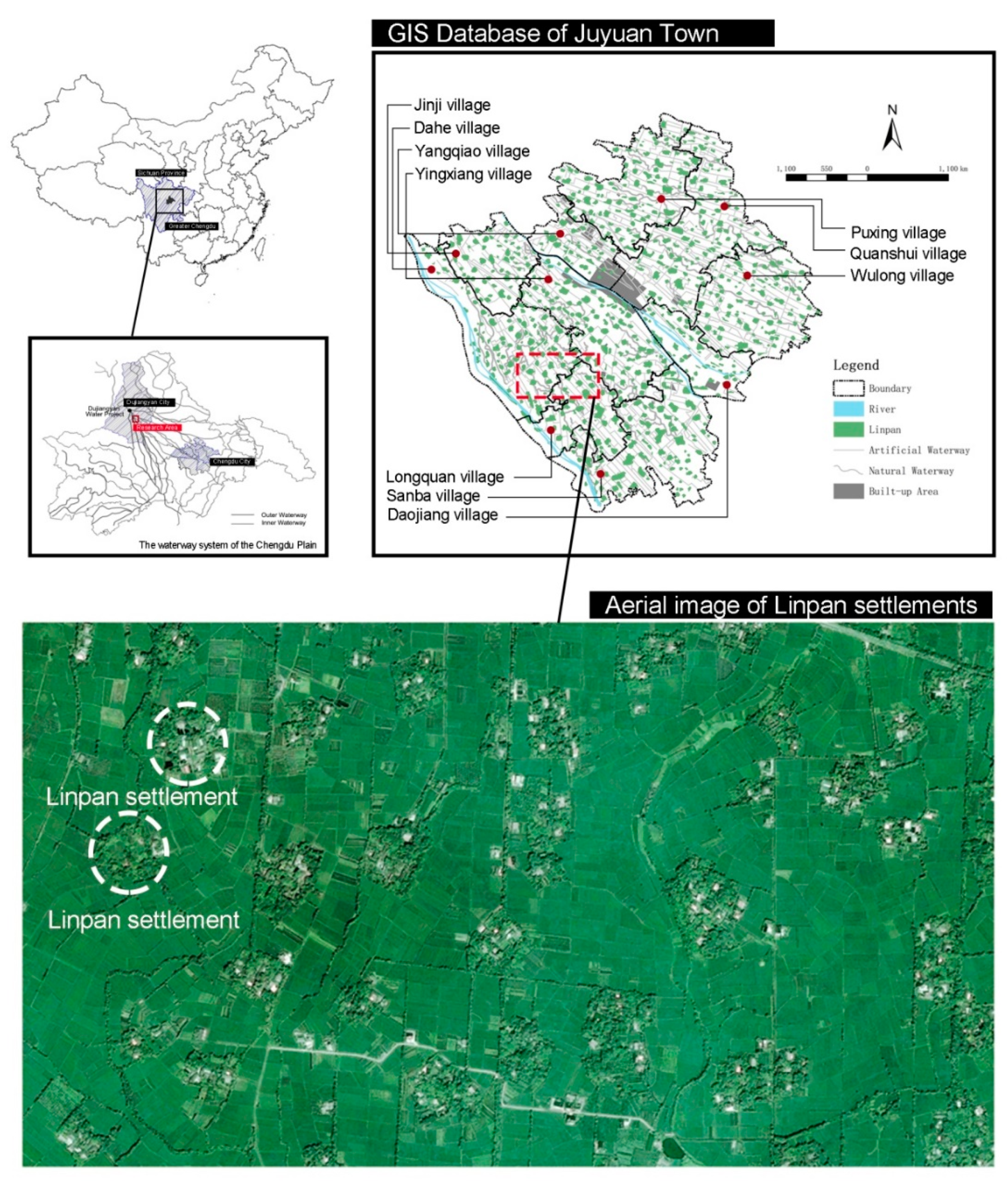
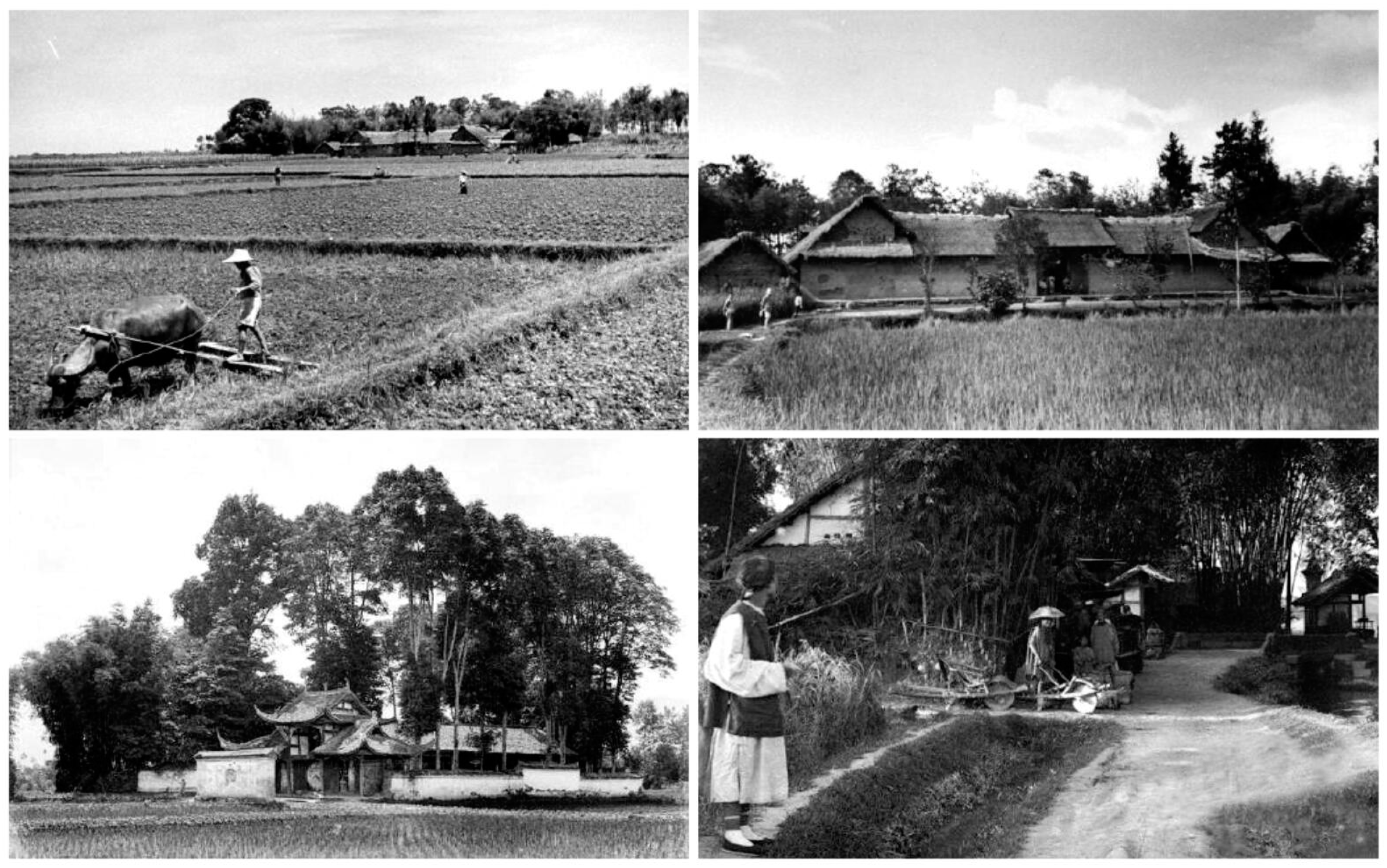
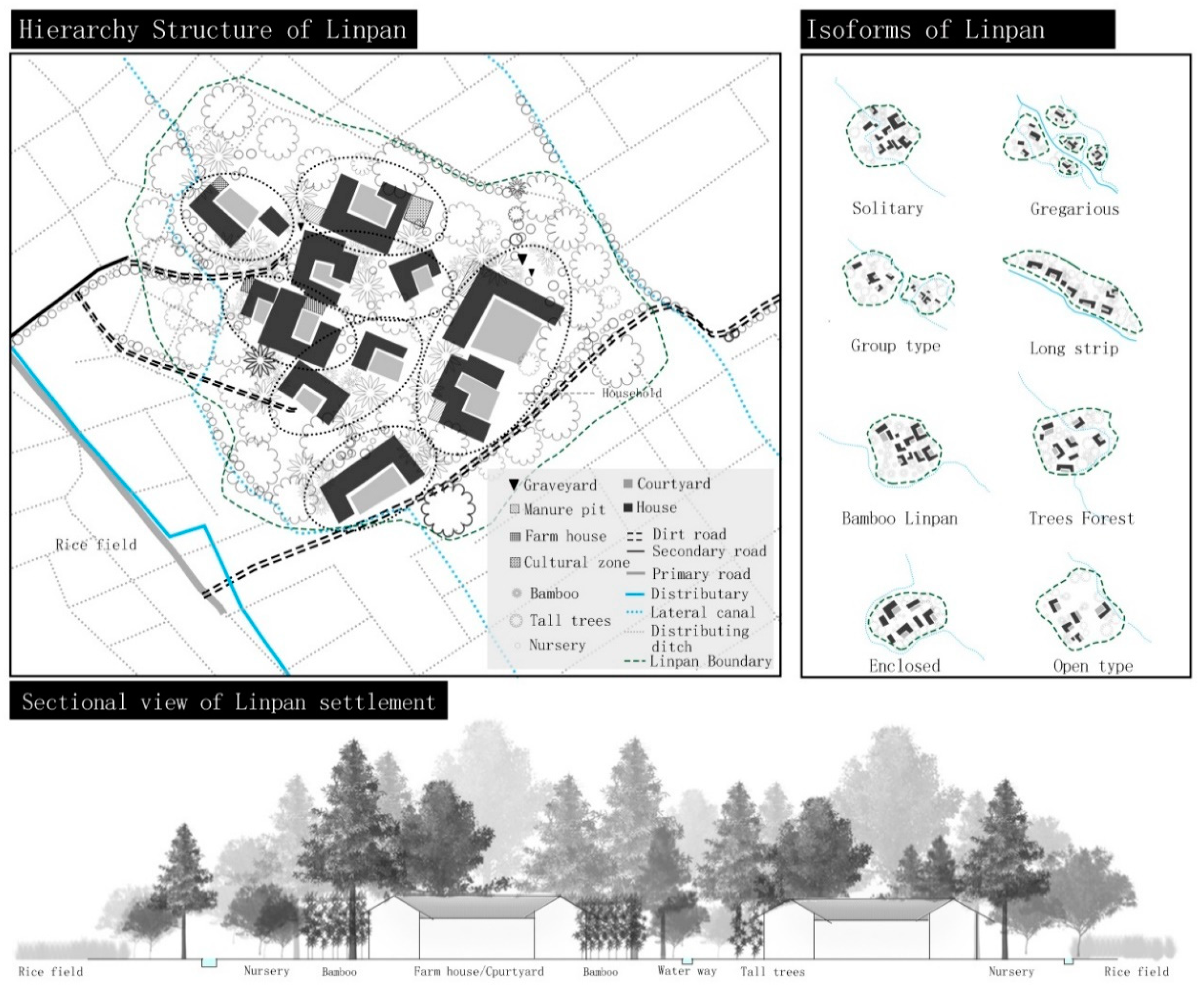
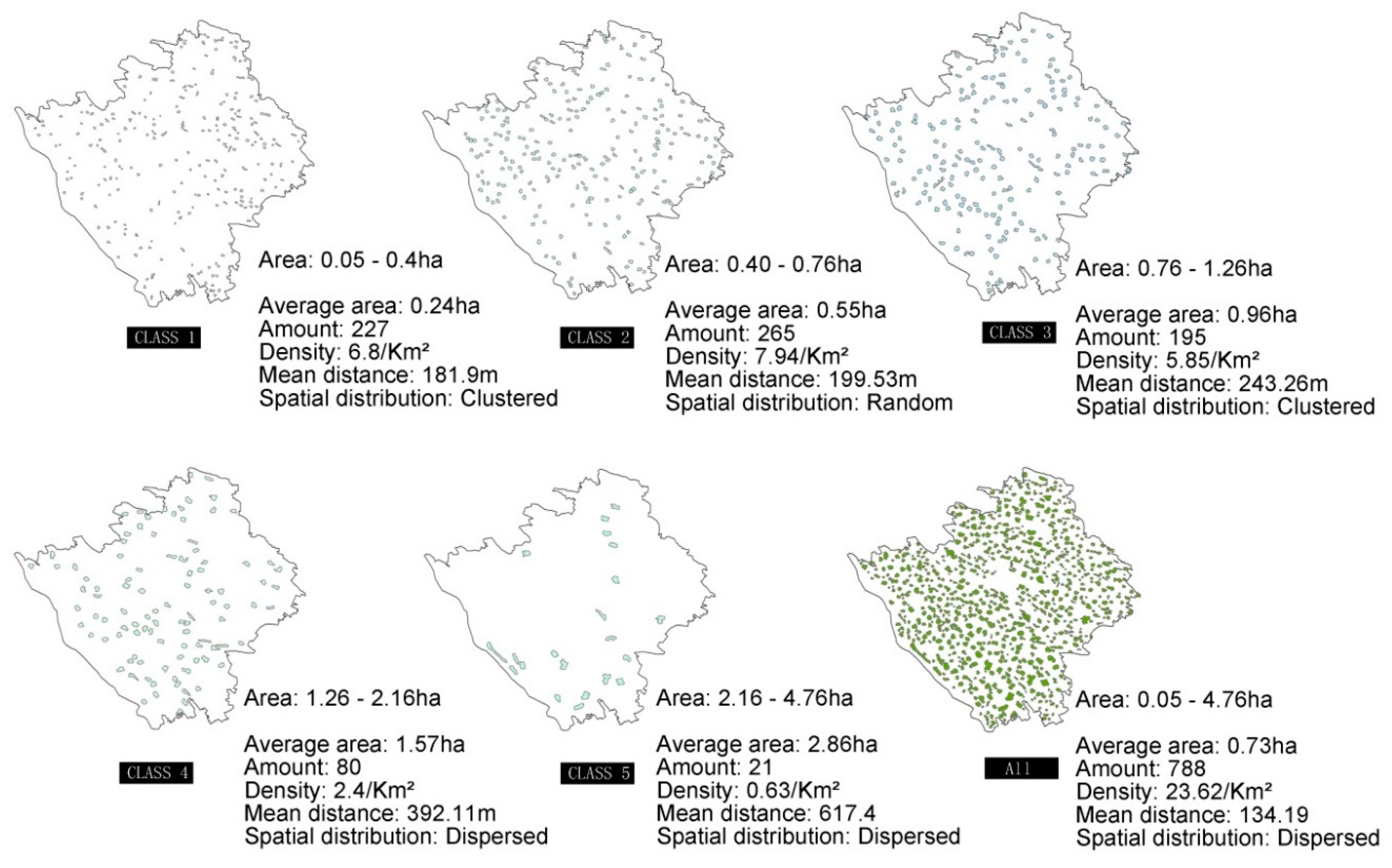
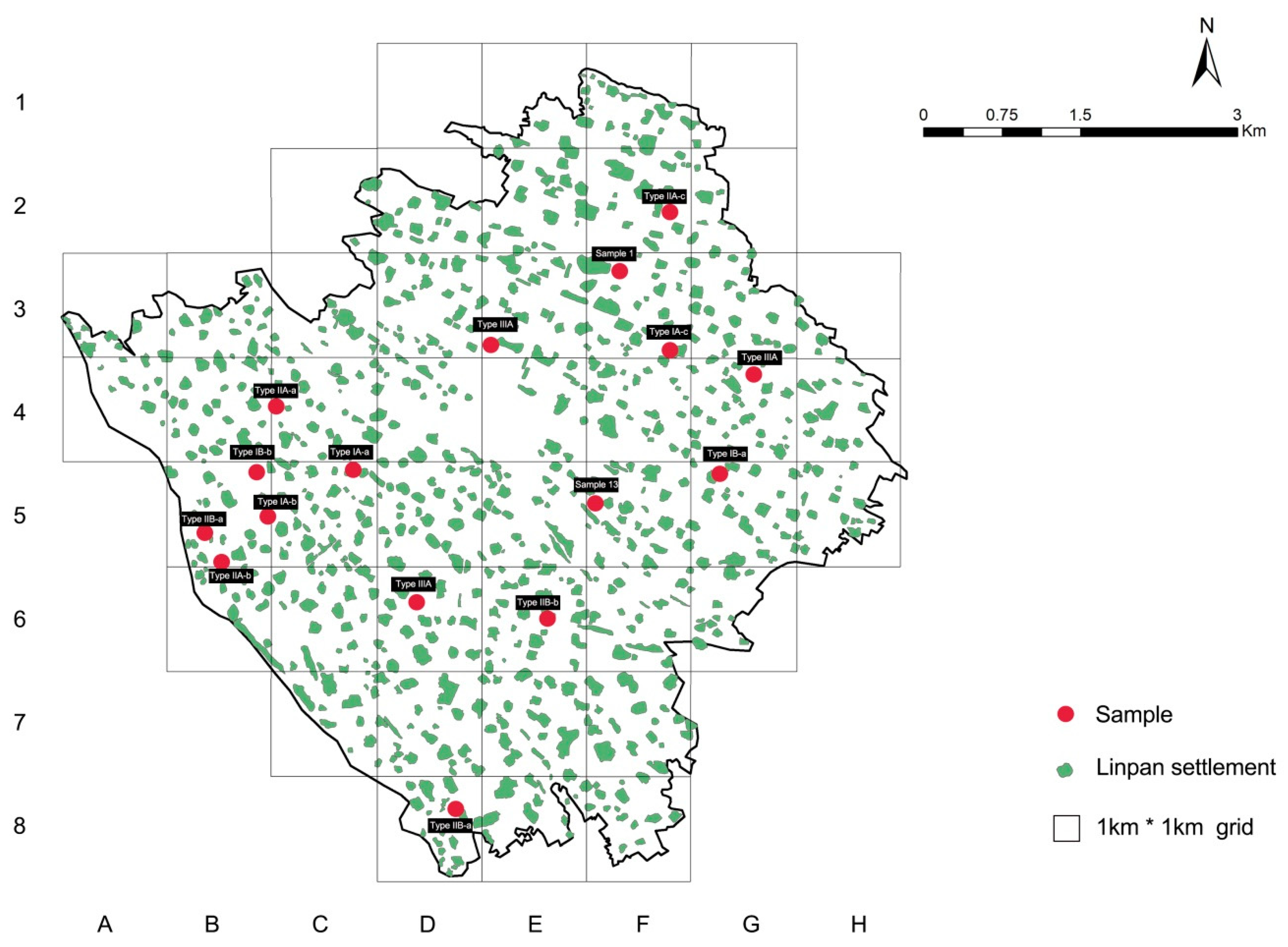
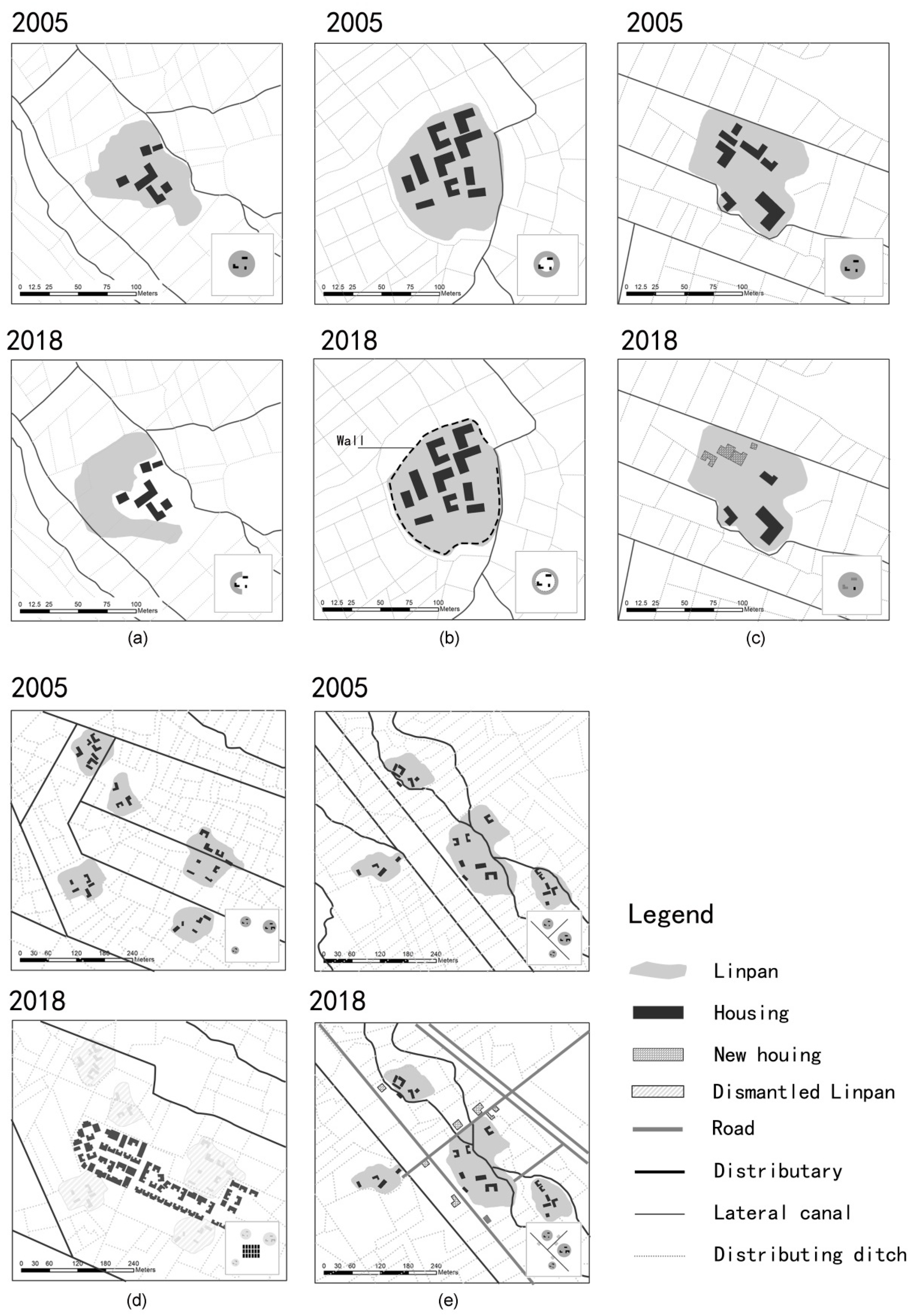
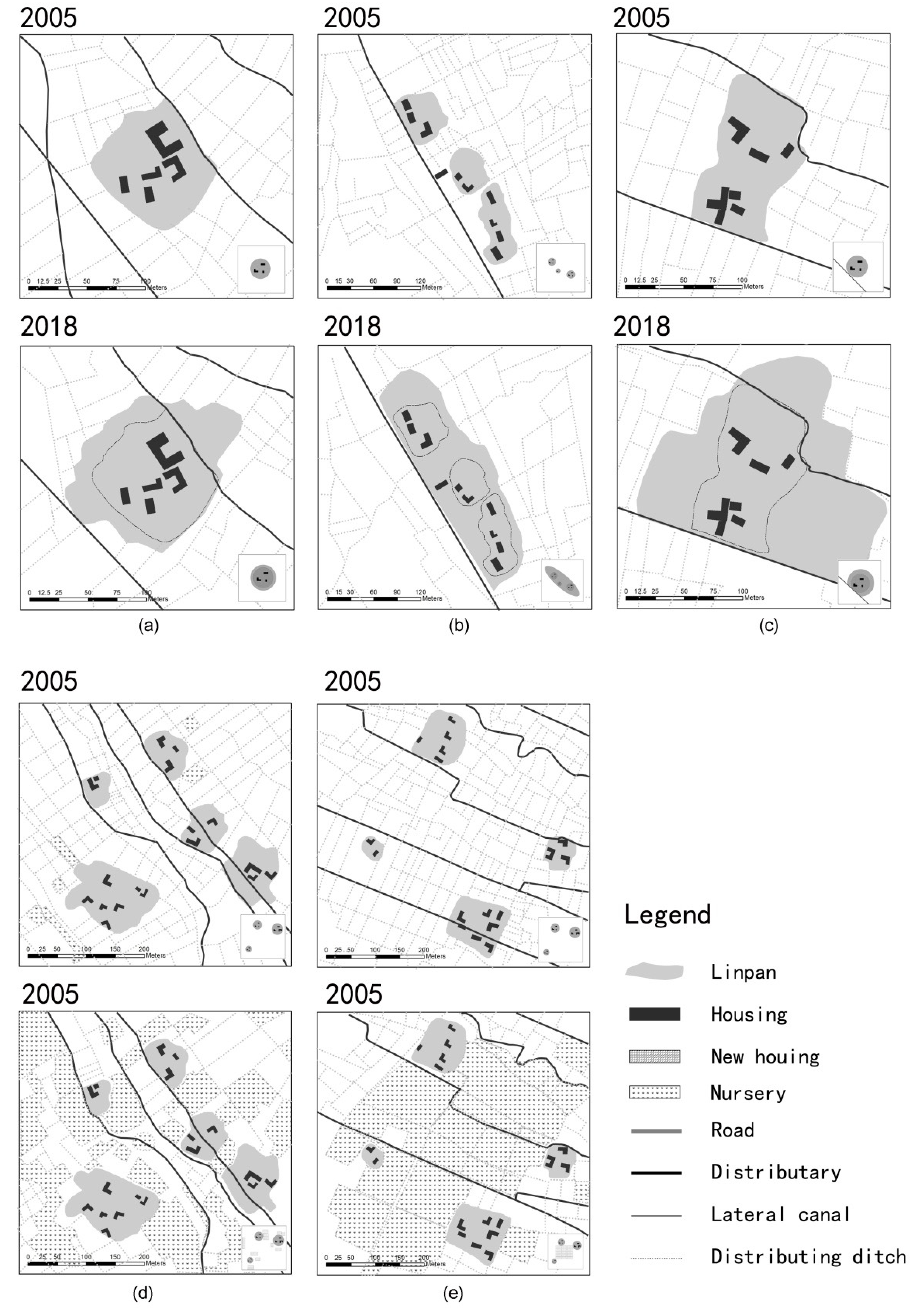
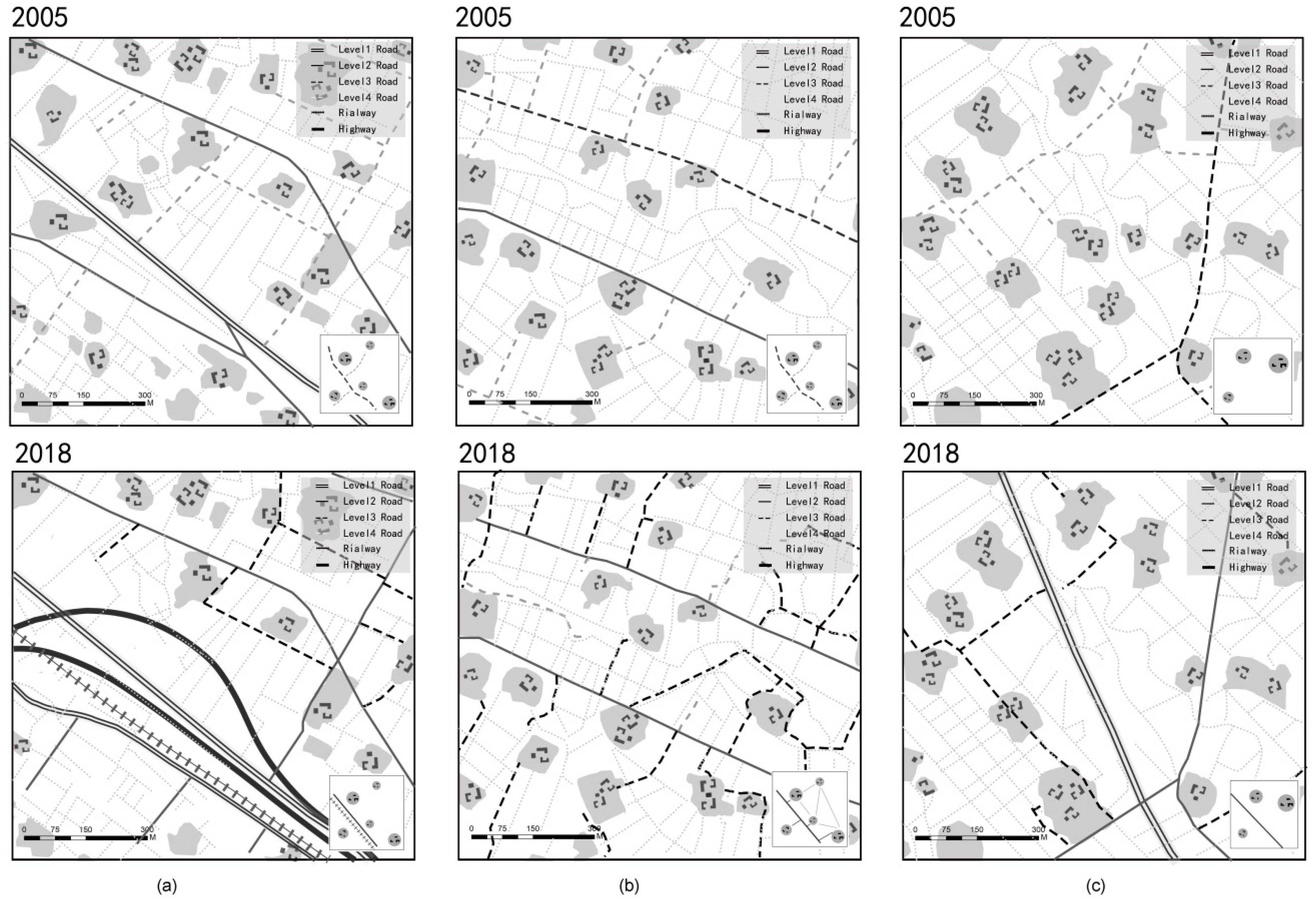
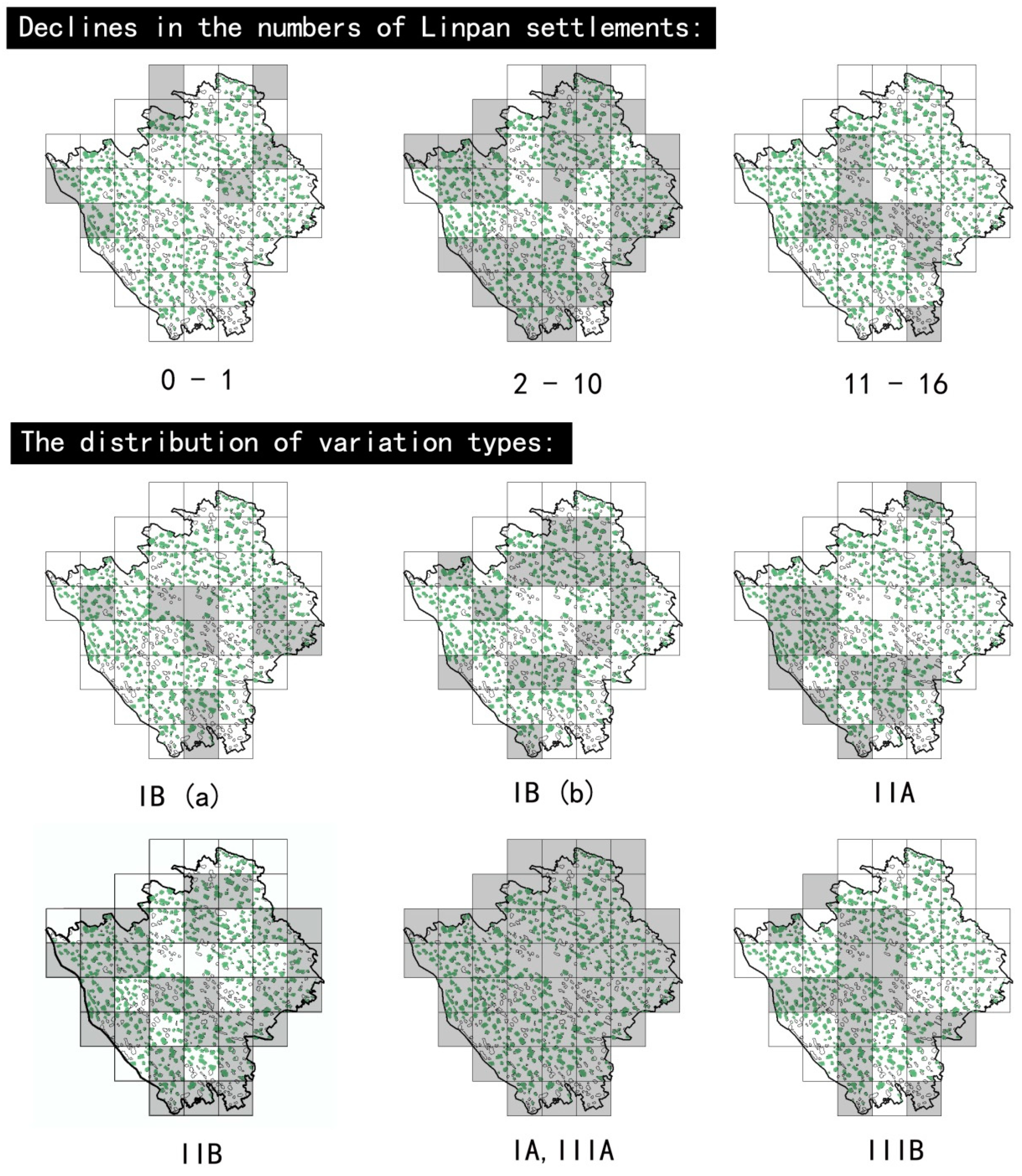
| Village Name | Buffer Area (ha) | Actual Cultivated Area (ha) | Village Domain Area (ha) | |||||||||
|---|---|---|---|---|---|---|---|---|---|---|---|---|
| 10 m | 20 m | 30 m | 40 m | 50 m | 60 m | 70 m | 80 m | 90 m | 100 m | |||
| Dahe Village | 41.98 | 90.87 | 146.99 | 209.98 | 280.17 | 357.42 | 441.81 | 533.26 | 631.69 | 737.19 | 313.55 | 445.63 |
| Daojiang Village | 16.31 | 35.13 | 56.62 | 80.94 | 107.97 | 137.86 | 170.67 | 206.30 | 244.90 | 286.38 | 129.75 | 185.26 |
| Jinji Village | 18.41 | 39.93 | 64.51 | 92.39 | 123.29 | 157.02 | 193.68 | 233.26 | 275.87 | 321.49 | 163.61 | 219.78 |
| Longquan Village | 18.69 | 40.30 | 64.87 | 92.40 | 122.66 | 155.62 | 191.13 | 229.28 | 270.10 | 313.49 | 151.90 | 211.81 |
| Puxing Village | 33.19 | 71.05 | 113.37 | 160.07 | 211.22 | 266.88 | 327.06 | 391.72 | 460.55 | 533.79 | 284.74 | 392.81 |
| Quanshui Village | 37.53 | 81.03 | 130.63 | 186.46 | 248.45 | 316.73 | 391.25 | 471.64 | 558.23 | 651.23 | 341.31 | 484.35 |
| Sanba Village | 40.07 | 85.84 | 137.27 | 194.51 | 257.50 | 326.38 | 401.15 | 481.78 | 568.15 | 660.09 | 333.07 | 459.39 |
| Wulong Village | 31.04 | 67.60 | 109.61 | 156.90 | 209.59 | 267.72 | 331.23 | 400.17 | 474.26 | 553.39 | 301.53 | 391.49 |
| Yangqiao Village | 13.13 | 28.64 | 46.57 | 66.77 | 89.28 | 114.05 | 141.07 | 170.33 | 202.00 | 235.99 | 87.68 | 159.74 |
| Yingxiang Village | 35.14 | 76.11 | 122.93 | 175.80 | 234.74 | 299.62 | 370.48 | 447.30 | 529.95 | 618.80 | 268.31 | 386.01 |
| Village Name | Tillage Pressure Coefficient (0 ≤ I) | |||||||||
|---|---|---|---|---|---|---|---|---|---|---|
| 10 m | 20 m | 30 m | 40 m | 50 m | 60 m | 70 m | 80 m | 90 m | 100 m | |
| Dahe Village | 0.13 | 0.29 | 0.47 | 0.67 | 0.89 | 1.14 | 1.41 | 1.70 | 2.01 | 2.35 |
| Daojiang Village | 0.13 | 0.27 | 0.44 | 0.62 | 0.83 | 1.06 | 1.32 | 1.59 | 1.89 | 2.21 |
| Jinji Village | 0.11 | 0.24 | 0.39 | 0.56 | 0.75 | 0.96 | 1.18 | 1.43 | 1.69 | 1.96 |
| Longquan Village | 0.12 | 0.27 | 0.43 | 0.61 | 0.81 | 1.02 | 1.26 | 1.51 | 1.78 | 2.06 |
| Puxing Village | 0.12 | 0.25 | 0.40 | 0.56 | 0.74 | 0.94 | 1.15 | 1.38 | 1.62 | 1.87 |
| Quanshui Village | 0.11 | 0.24 | 0.38 | 0.55 | 0.73 | 0.93 | 1.15 | 1.38 | 1.64 | 1.91 |
| Sanba Village | 0.12 | 0.26 | 0.41 | 0.58 | 0.77 | 0.98 | 1.20 | 1.45 | 1.71 | 1.98 |
| Wulong Village | 0.10 | 0.22 | 0.36 | 0.52 | 0.70 | 0.89 | 1.10 | 1.33 | 1.57 | 1.84 |
| Yangqiao Village | 0.15 | 0.33 | 0.53 | 0.76 | 1.02 | 1.30 | 1.61 | 1.94 | 2.30 | 2.69 |
| Yingxiang Village | 0.13 | 0.28 | 0.46 | 0.66 | 0.87 | 1.12 | 1.38 | 1.67 | 1.98 | 2.31 |
| Type | Changes in Spatial Hierarchy | Needs Level | |||
|---|---|---|---|---|---|
| I | Internal changes | IA | on-site update | a. spatial replacement | Survival |
| b. functional replacement | Survival | ||||
| c. old-for-new house replacement | Survival | ||||
| IB | off-site migration | a. concentration in new villages | Development | ||
| b. off-site construction | Survival | ||||
| II | Changes in shape | IIA | expansion of native forest | a. unconstrained expansion | Survival |
| b. joint expansion | Survival | ||||
| c. constrained expansion | Survival | ||||
| IIB | planting of economic forest | a. non-scale planting | Development | ||
| b. large-scale planting | Development | ||||
| III | External landscape changes | IIIA | municipal infrastructure construction | a. enhancement and new construction of roads | Development |
| IIIB | social infrastructure construction | a. construction of public facilities and business organizations | Quality | ||
© 2019 by the authors. Licensee MDPI, Basel, Switzerland. This article is an open access article distributed under the terms and conditions of the Creative Commons Attribution (CC BY) license (http://creativecommons.org/licenses/by/4.0/).
Share and Cite
Li, Q.; Wumaier, K.; Ishikawa, M. The Spatial Analysis and Sustainability of Rural Cultural Landscapes: Linpan Settlements in China’s Chengdu Plain. Sustainability 2019, 11, 4431. https://doi.org/10.3390/su11164431
Li Q, Wumaier K, Ishikawa M. The Spatial Analysis and Sustainability of Rural Cultural Landscapes: Linpan Settlements in China’s Chengdu Plain. Sustainability. 2019; 11(16):4431. https://doi.org/10.3390/su11164431
Chicago/Turabian StyleLi, Qiushan, Kabilijiang Wumaier, and Mikiko Ishikawa. 2019. "The Spatial Analysis and Sustainability of Rural Cultural Landscapes: Linpan Settlements in China’s Chengdu Plain" Sustainability 11, no. 16: 4431. https://doi.org/10.3390/su11164431
APA StyleLi, Q., Wumaier, K., & Ishikawa, M. (2019). The Spatial Analysis and Sustainability of Rural Cultural Landscapes: Linpan Settlements in China’s Chengdu Plain. Sustainability, 11(16), 4431. https://doi.org/10.3390/su11164431





